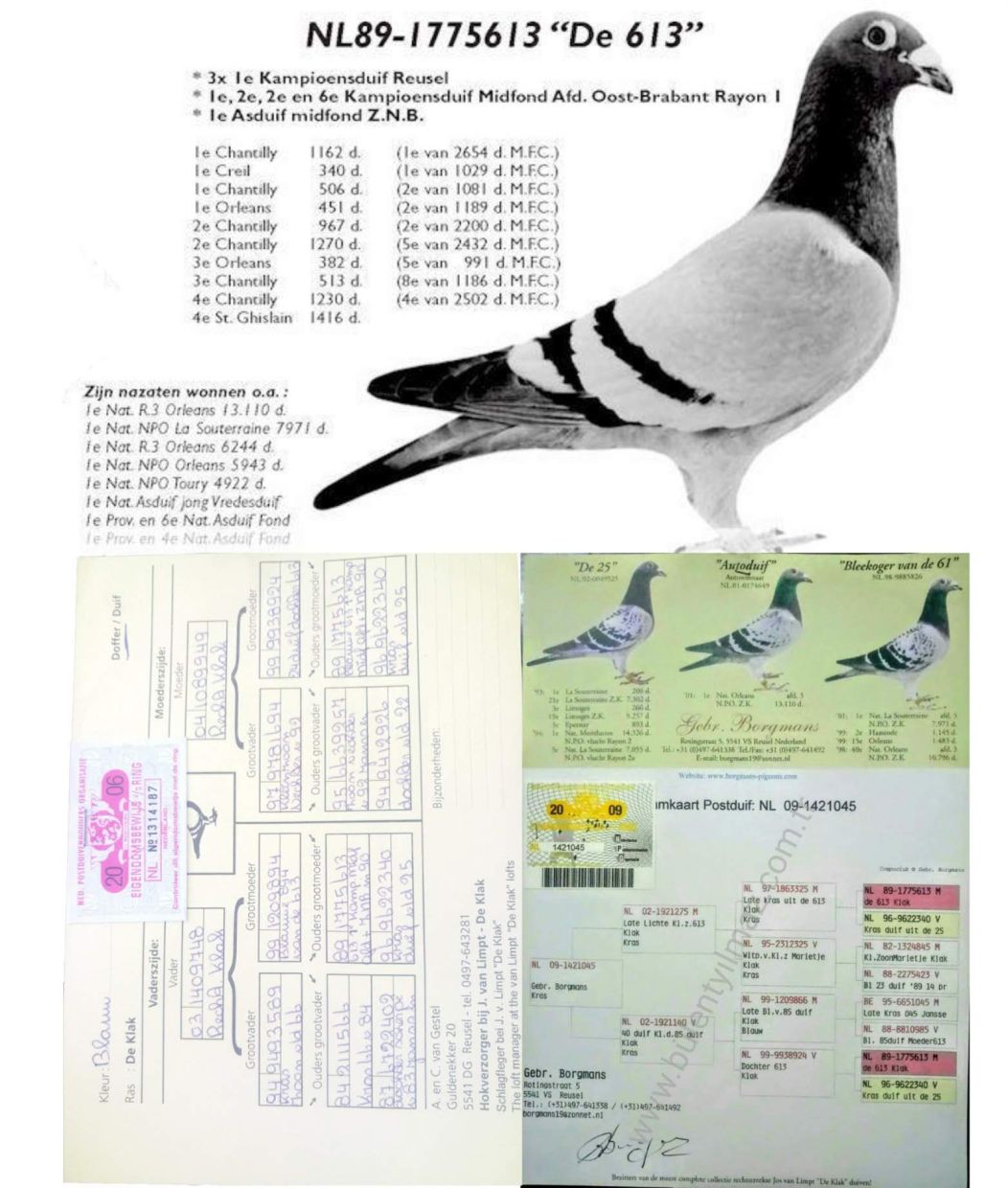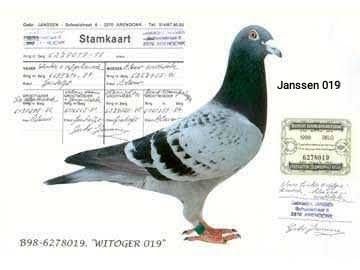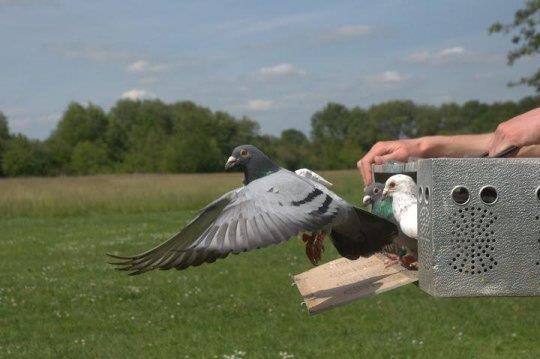


.jpg)

.jpg)
.jpg)

The natural system flying mated

The natural system flying mated
Panders are always seeking methods by which the pigeons may be urged to race home faster. One cannot hope to find a better jockey to assist in this matter than the pigeon's own natural instinct.
First and most important for the pigeons is food and water. Once this has been foreseen, the next in line of importance is the desire to find a mate and breed. Fanciers have tried to make use of these instincts in attempts to improve upon the performances of their pigeons. Of the two instincts, the first, namely hunger and thirst, has proved to be an excellent instrument for use in acquiring control over one's pigeons, whilst the second has been directed towards the improvement of race results.
Flying mated pigeons is certainly the oldest known method of racing. Each fancier making use of this system has, by experience, developed his own system, using a number of tricks to motivate the pigeon and create the desired anxiety which will, he hopes, induce it to make a special effort to reach home in the shortest possible time. This method has its advantages and, if correctly applied, certainly gives the fancier the required results. However it also requires a great deal of knowledge, experience and observation from the fancier. The fancier who tackles this system of racing must be prepared to do a lot of paper work and keep very accurate records.
This is because one cannot always be certain about the number of days a pigeon has been sitting or feeding, when sent to the race. Pigeons are raced during the different stages of the breeding cycle starting when the pigeons are just mated, followed then by driving cocks, and pigeons sitting on eggs, or youngsters. The cycle is then repeated.
The fancier who wishes to race his pigeons on this system must realize that he is starting with a long, but very interesting, study. He will succeed only after several years of patient, consciencious and observant study. The most important factor in this racing method is that each pigeon be treated as an individual ; the fancier must find out during which nesting condition the pigeon reaches its peak form and books its best performances.
The individual attention paid to each pigeon makes it impossible to handle a large team of racers. It is altogether wrong te generalise results obtained on certain nesting conditions and therefore one cannot speak of a single condition which will guarantee better results with all pigeons. There are certain conditions which are favoured by many pigeons, yet one cannot put one's money on a pigeon just because it is in one of one's own favourite nesting conditions. The fancier must first find out whether the pigeon itself favours that particular condition and then make sure that it also reaches its top physical condition at the same time.
In the previous chapter we spoke about the physical and mental condition of the pigeon with emphasis upon the physical condition. This chapter deals with the pigeon's mental condition and how to create it, not forgetting that the race can only be won by an extra fit pigeon in the right mental condition.
If a pigeon is sent to a race in a favoured nesting condition, but in poor physical condition, its love for its mate, nest or youngsters, or even jealousy, will drive it until it is so exhausted from fatigue, that it cannot fly any further. It is then either lost or will fly until it dies. For this reason the fancier must be sure both that the pigeon's physical condition is such that it can complete the race and that its mental condition will then drive it home at the fastest possible speed. Some pigeons are very keen on the nest with fresh eggs. It is up to the fancier to discover this fact and to apply the knowledge to the best advantage. I have often found a hen sitting on hatching eggs very keen, so that by giving her more eggs to sit on, one can increase her anxiety. By removing the cock the evening before basketing day and allowing the hen to sit all day one can also help to bring her into the desired mental condition. If she is to be sent to a short race, it helps to take her off the eggs a few times during the day, and then either to chase her out for a flip around the loft or to take her on a short toss of one or two kilometres.
She will race back to the loft like a bullet and, if experienced enough and in top physical condition on race day, will do the same.
The same procedure may be followed with cocks ; and if a youngster is slipped under a pigeon sitting more than fifteen days, good results may be expected.
These tricks bring about a degree of anxiety in the pigeons and create a particular mental condition. I must, however, warn that, if this anxiety is driven too far, it will have an adverse effect, since one stands a chance even of loosing an overkeen pigeon.
I have always picked my pigeons for the coming week's race on the previous Saturday, while waiting for my birds to return from the race.
The pigeons in the race will only be considered if they have done well and are still in peak physical condition after the race.
For the next week's race I choose only a few candidates and then endeavour to get them into the desired physical condition during the week. This is done by adjusting feeding or by increasing the amount of exercise given ; the increase in exercise may be achieved either by prolonging their daily training around the loft or by tossing. It sometimes even helps to reduce the amount of exercise given, to get a pigeon into top physical condition. This is why I have emphasized the importance of individual attention. From the chosen candidates I will eliminate until I have only two
or three left which are both in top physical condition and also in the right nesting condition to create the required mental condition. My pool and nomination birds will come from these last few selections.
I usually give all my attention to the pigeon's physical condition during the first few days of the week and, depending on the basketing day, only concentrate on the mental condition during the last two days before basketing. This it the time to decide what tricks one should use, if necessary, to create the correct mental condition. Tricks are only played on pigeons which are not in the favoured nest condition, in a case such as driving cocks, were an egg is slipped. Another case would be pigeons sitting on eggs of fifteen days old or older which have previously shown keeness for chipping eggs, or if not available, an egg in which a grasshopper or cricket has been placed. A few years ago I still had to blow out an egg for this purpose but now plastic eggs with removable sides are available. Unfortunately they have not as yet been able to provide the grasshopper or cricket, so that I have had to spend a lot of time searching for these vital ingredients which, in winter time, are not very plentiful.
In hot countries it can also be fatal to send a pigeon to a race while sitting on hatching eggs or feeding a small youngster of up to five days especially when it is while sitting on its first round of eggs for the season. This applies more to yearlings, yet older birds also sometimes suffer from too much pigeon milk. The milk can become sour, turn bad and can cause the pigeon's death. It is therefore inadvisable to fly pigeons on this method when you can not be assured that liberation will take place the next day.
Pigeons sitting on eggs up to ten days old give good results, whilst the period between ten and fifteen days is less favourable. In this period I have found that, by adding one egg to the nest each day until there are four or five eggs in the nest, one can also increase the anxiety, which
sometimes bring the desired keeness. Keen observation will soon tell the fancier which of the two, the hen or the cock, are the keenest.
Driving cocks can also be flown sucessfully if they receive the necessary training beforehand. I have always found that certain families fly better than others under certain conditions. It is up to the fancier to discover these family specialities.
When you intend racing a yearling cock in a driving condition, it pays to throw him out for a trip around the loft a few times and then allow him to find his hen in the loft on his return. A short toss, as is done with the hen sitting on eggs or a chipping egg, also helps. However, I prefer not to race a yearling cock in this condition. Older cocks are more reliable than yearlings when flown in a driving condition. I prefer to try and trick the young cock by putting an egg in its nest some ten minutes before basketing. The eggs usually causes the bird to calm down and reduces the risk of losing it because of an over-excited mental condition.
One should also select the type of cock to be raced in a driving condition. Cocks driving madly are too excited and seldom race well in such a condition. Furthermore they very seldom reach peak physical condition during this period.
My preference goes to the cock which simply watches his hen without letting her out of his sight. He stands behind her when she is not in the nestbox and pecks at her head occasionally, without actually driving her.
On one occasion I basketed two old cocks which were only driving slightly as described in the previous paragraph. They had both scored previously but I favoured them for this race because they were both due to start a second nest. The race was from Ventersburg 285 km and a fastrace was expected. They obliged by taking second and fourth club at a velocity of 1350 metres per minute. I have always found that driving cocks do better in fast races.
Due to the short duration of this condition one does not always catch a pigeon in it on basketing day. I have tried to prolong the condition by removing the hen from the loft during the day, but had seldom success.
When flying mated one must always be on the look out for the abnormal behaviour in one's pigeons as this usually is an important indication. Any pigeon reacting in an unusual way normally displays some form of keenness, such as cocks sitting at unusual hours, or hens sitting during the day time when they should be off. Among the pointers to winners are in order of success, pigeons on hatching or sitting on a small youngster, pigeons sitting on eggs up to ten days old, pigeons on a fresh nest and still feeding a baby and old cocks sent driving. Pigeons on others conditions, such as an outsider, sometimes fill up the gaps.